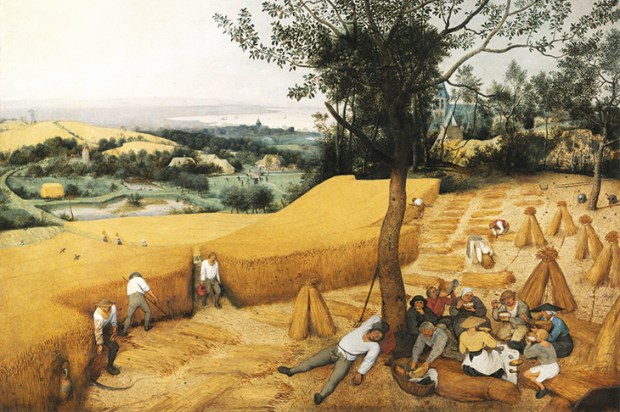When an American describes a woman as wearing a ‘Park Avenue Helmet’ you know exactly what is meant. This is a hairdo so precise and sculpted that it trembles, category-wise, between coiffure and armour. Both natural and artificial, it also accurately signals social status.
The link between hats, hair and caste was first made by James Laver in his 1937 classic Taste and Fashion, a book not yet bettered in its field. Oddly, it does not appear in the bibliography of Drake Stutesman’s new cultural history of headwear. But to be fair to NYU’s Professor Stutesman, she does make the compensatingly interesting point that one of the reasons for the decline of the woman’s hat in the 1950s was the introduction of the deadly fixative hairspray, which made the Park Avenue Helmet possible in the first place.
Hat is a good and handsome book, despite its intellectual origins being in Roland Barthes’s mischievous essays deconstructing pop culture. I was always worried I might stumble across a Barthesian ‘signifying matrix’. I know about these things because, to confess, at the right-on university which once employed me, I proposed an inter-disciplinary course on ‘Soap’, which the faculty board took more seriously than I had intended.
In this style, Stutesman’s previous book was a cultural history of the snake. Americans do not always possess irony, so we must take her word for it when she also describes herself as a ‘radical literary novelist’. But headwear is a preoccupation: she is engaged long-term to a study of Mr John, the designer of Vivien Leigh’s hats in Gone With the Wind.
The hat has been known in all cultures since prehistory, evocative of power and status. Bishops and professors have seats and chairs, but they also have peculiar headwear. And what is a crown but a coruscating metal hat? When Lady Llanover invented Welsh national costume in the 1830s, the woman’s stovepipe hat was an outstanding feature. A picture in Hat misidentifies some of Lady Llanover’s 19th-century Welshwomen as ‘witches’ — although those of us with Welsh relatives might see Freud in this slip.
Stutesman is your go-to prof for authoritative comment on the Nigerian ade, Flemish hennin, Muslim kufi, Korean gat, Shinto tate-enoshi, the cardinal’s beretta, the Jewish yarmulke and the Berber tagalmust. She is also good on French 18th-century social history, although the technique of precis has not been rigorously applied.
But the price to be paid for so much good-natured expertise is for the reader to experience a wobbling high-wire act of Advanced Professorialism. One long paragraph is devoted to an argument about what is meant by ‘thing’ (apparently ‘something which has an existence’). A footnote glosses ‘known’ as signifying ‘what has already been discovered to date’.Then the fact that a hat is in a relationship with the head is a ‘plan of symbolic conjunction’. Before I had time to reach for my well-thumbed Structuralist dictionary, we were on to the phallo-yonic stuff, as I knew we soon would be.
Power always has a sexual character, but other factors contributed to the hat’s erotic dimension. In 18th-century Paris, milliners were explicitly associated with debauchery and prostitution, the two trades often operating, to mutual benefit, on the same premises. Indeed, the libidinous Coco Chanel began her career as a milliner. And the cloche hat of 1920s flappers denoted a no-nonsense functionalism whose sexual suggestiveness was not at all occult.
But my favourite passages in Hat concerns not post-doctoral NYU speculation about the sexual projection of the bowler or the boater but the manufacture of felt. This required mercury, exposure to which reliably caused the peripheral neuropathy which gave us Lewis Carroll’s Mad Hatter.
The hat appears also in two other late 19th-century classics. George du Maurier’s 1895 Trilby introduced us to both the name of a hat and the mysterious Svengali; while, in 1900, the influential modernist architect Adolf Loos (famous for equating ornament with crime) published an essay in Ins Leere Gesprochen (Spoken into the Void), arguing against ephemeral fashion but enthusing about the middle-class man’s hat as a useful exercise in masculine brand extension.
Curiously, Hat becomes less satisfactory the closer it approaches the present. I wanted to know more about the endless permutations of the American baseball cap. Why does Lewis Hamilton insist on a ghetto-centric snapback when his Grand Prix team mate wears a cap more like Hemingway’s long-billed Quaker Marine Supply Oysterman? Tell me more about Tom Wolfe’s fedora, the chef Marc Veyrat’s Savoyard and Dominic Cummings’s beanie. Why does Philip Treacy’s extravagantly contrarian silliness fascinate so? Is Trump’s red prole trucker’s cap the non-college white’s equivalent of the Illyrian pileus?
And Stutesman misses my all-time favourite hat anecdote. On his African travels in the 1930s, Evelyn Waugh came across an isolated tribe whose habit was cheerfully to disport themselves naked at all times — except for the discarded homburg hats which they eagerly adopted. They were not using the hat as Stutesman’s ‘extension of the multi-tasking head’, but as a device which changes your status even more than your style.
Nice that a reverence for the decoration of your head unites Park Avenue ladies who lunch and Waugh’s savanna tribesmen who, behatted, dance. Professor Stutesman? A few quibbles, but on the whole: chapeau! Or, in English, I take my hat off to you.
Got something to add? Join the discussion and comment below.
Get 10 issues for just $10
Subscribe to The Spectator Australia today for the next 10 magazine issues, plus full online access, for just $10.
You might disagree with half of it, but you’ll enjoy reading all of it. Try your first month for free, then just $2 a week for the remainder of your first year.














Comments
Don't miss out
Join the conversation with other Spectator Australia readers. Subscribe to leave a comment.
SUBSCRIBEAlready a subscriber? Log in